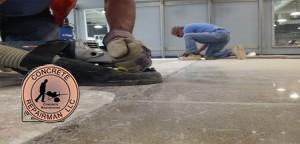Foundation Repair Concrete Repairman® We Fix It Right™
Licensed, Bonded and Insured Commercial & Residential Foundation Repair Contractors - ROC# 300512 CR-9
Foundation Repair Concrete Repairman® We Fix It Right™
Licensed, Bonded and Insured Commercial & Residential Foundation Repair Contractors - ROC# 300512 CR-9

If you plan to overlay or restore existing concrete, proper surface preparation is essential to achieving good results
Preparing concrete surfaces for finishing is a time-consuming task that many contractors perform begrudgingly or are tempted to overlook altogether. But if you’ve ever skipped this essential first step in the process, you undoubtedly learned the hard way how critical it is to the success of the job.
Concrete surfaces are prepared prior to resurfacing concrete to look like plain concrete again or to be upgraded to a decorative finish. Today polymers can be applied as thin as 1/8 ” or up to 3/4″ thick and stamped, producing a surface that looks just like a normal stamped concrete surface.
Surfaces are also prepared prior to various floor-coating installations in industrial, commercial, and institutional applications. The most important characteristic for resurfacing materials or floor coatings is the texture of the concrete. This section offers an overview of the steps required for surface preparation as well as an introduction to the machinery that is used.
You can’t ever be too prepared. The information below will help you get organized before starting surface preparation work. Without taking these things into consideration you could end up doing more harm than good.
Architects, Engineers, Property Owners, and Other Important People: Job Planning
Job planning requires the important people in a project know any special requirements they have prior to the project being put out to bid.
Examine the Surface
Prior to contracting for a job or awarding a project- the contractor must conduct a survey of the concrete surface in its current shape.
If excessive laitance is present (a weak layer of cement and fines on the concrete surface), this material must be removed down to solid concrete. The coating or overlay will not bond properly to the weak layer of concrete.
The surface should be checked for existing sealers, curing materials, grease, oil, efflorescence, and dirt that need to be removed. In short, you want no surprises.
Know the Job Specifications
Most job specifications for surface preparation state the surface should be “sound, free from surface defects dry, and clean.” Each of these terms is subjective, so it is important that the job specifications, the coatings or overlay specifications, and the expectations of the architect and/ or project engineer are in alignment.
Specifications should also say how uniform, clean, rough, and what strength the concrete substrate should be prior to a coating or overlay installation. See “Standards You Should Know About”
Proposals for surface preparation specifications should clearly spell out cleaning methods, profiling method, and surface defect repair procedures.
Other specifications may include time schedules and acceptable levels of noise and dust. Also, is there time in the schedule for concrete to dry to the required moisture level if water is being used in the cleaning process? If the specifications don’t cover these issues- make sure they get covered.